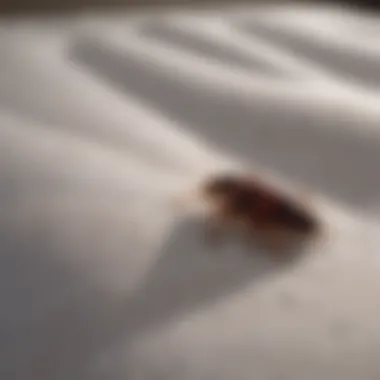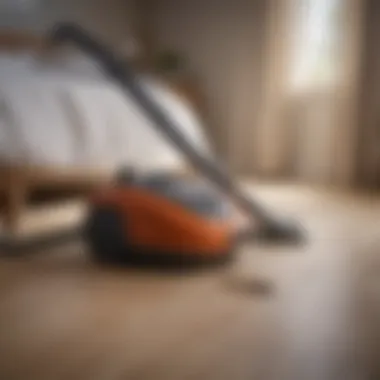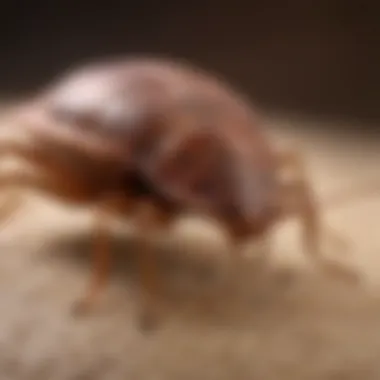Will Vacuuming Kill Bed Bugs? An In-Depth Examination


Intro
Bed bugs remain a persistent nuisance for many households. These small, elusive insects thrive in environments where humans sleep and spend significant time. Their bites can cause discomfort and irritation, leading to a search for effective elimination methods. This article examines the role of vacuuming in the battle against bed bug infestations. To truly understand whether vacuuming can kill bed bugs, it is essential to explore their behavior, the effectiveness of this cleaning method, and additional strategies for managing a bed bug problem.
Understanding Pests
Definition of Pests
In the context of home management, pests are organisms that cause harm, annoyance, or disease to humans, pets, and property. Bed bugs fall into this category, as they feed on human blood and can trigger allergic reactions in sensitive individuals. Their presence signals a larger problem, often indicating deeper issues of hygiene and sanitation within a home.
Importance of Pest Identification
Identifying pests accurately is crucial for effective treatment. Bed bugs, scientifically known as Cimex lectularius, are often confused with other household insects. Correct identification allows for targeted pest control techniques. Understanding bed bug life cycles and habits enhances homeowners' ability to manage infestations effectively. Knowledge about their nocturnal behavior, reproduction rates, and hiding spots contributes to a comprehensive pest management approach.
Vacuuming as a Bed Bug Control Method
Vacuuming is a common cleaning technique that many people consider when addressing bed bug issues. The primary objective is to remove as many visible bed bugs as possible, along with their eggs and exoskeletons. However, while vacuuming can be a part of a broader strategy, it has its limitations.
Effectiveness of Vacuuming
Vacuuming may remove some bed bugs, especially those that are hiding in accessible areas. Specifically, the following aspects play a role in how effective this method can be:
- Suction Power: Stronger vacuums can remove smaller insects and debris more effectively.
- Attachment Tools: Specialized tools help get into corners and cracks where bed bugs may hide.
- Proper Technique: Focusing on areas where bed bugs are likely to reside, such as mattress seams and box springs, enhances efficacy.
Despite these benefits, vacuuming alone is unlikely to eliminate an infestation. Some bed bugs can survive the vacuuming process, particularly if they are deeper in a mattress or furniture. Moreover, eggs, which are often stuck to surfaces, are not easily removed.
Limitations of Vacuuming
While vacuuming plays a supportive role, limitations must be recognized. Vacuuming cannot guarantee complete removal of bed bugs. The following are key limitations:
- Survivability: Bed bugs may survive if not immediately captured.
- Eggs: Vacuuming does not always eliminate eggs, which can hatch later to reinfest the area.
- Dispersal: Vacuuming might cause bed bugs to scatter rather than gather for capture.
It's essential to use vacuuming within a broader pest control strategy, combining it with other methods for optimal results.
Complementary Strategies
To effectively combat bed bugs, homeowners should complement vacuuming with additional strategies. Such methods include:
- Washing Bedding: High temperatures can kill bed bugs in linens and clothing.
- Encasements: Special mattress and box spring encasements can trap and suffocate any bed bugs inside.
- Professional Treatment: Sometimes, a professional exterminator is the best option to tackle advanced infestations.
"An isolated approach rarely proves effective. Integrated pest management, which combines various techniques, provides the best chance of eliminating bed bugs completely."
Finale
In summary, vacuuming can be a helpful initial step in managing a bed bug problem, but it cannot stand alone as the sole solution. The understanding of bed bug behavior, combined with complementary treatments, is essential for effective pest control. Homeowners must be vigilant, proactive, and informed when dealing with these persistent pests to ensure a restful and bug-free home.
Intro to Bed Bugs
Understanding bed bugs is critical in tackling infestations effectively. These pests are small but potent adversaries, capable of causing significant distress and discomfort. Knowledge about their behaviors and characteristics forms the basis for effective treatment strategies. Bed bugs have a unique ability to thrive in various environments, making it essential for homeowners to grasp the basics of their biology.
The presence of bed bugs can lead to more than just physical annoyance. They disrupt sleep quality and can provoke anxiety in those dealing with infestations. Moreover, misconceptions surrounding these pests can also hinder effective control measures.
Understanding Bed Bug Biology
Bed bugs, scientifically known as Cimex lectularius, are nocturnal insects that feed on human blood. Their flat bodies allow them to hide in tiny crevices and make them adept at eluding detection. Adult bed bugs are about the size of an apple seed and are reddish-brown, while their eggs are nearly invisible, complicating management efforts.
The biology of bed bugs also includes behaviors that make them resilient. For instance, they can go weeks without feeding, allowing them to survive during periods without a host. Through interactions with their environment, they communicate through scent and pheromones, playing a role in mating and aggregation.


The Life Cycle of Bed Bugs
The life cycle of bed bugs consists of several stages: egg, nymph, and adult. Understanding this cycle is vital for strategizing effective control measures. A single female bed bug can lay hundreds of eggs in her lifespan, which typically lasts about six to twelve months. Here is a brief overview of the stages:
- Eggs: Tiny and white, they can be laid in clusters. Each female can produce up to five eggs a day.
- Nymphs: These younger forms resemble adults but are smaller and lighter in color. They require blood meals to advance to the next stage.
- Adults: After five molts, nymphs become adults. They can reproduce quickly, perpetuating the cycle if not managed.
The rapid reproduction and growth cycle highlight the need for timely action against bed bugs. Knowledge of their life stages aids in identifying when infestations are most manageable.
"Awareness is the first step toward effective pest control. Understanding bed bugs leads to informed strategies to combat them."
By delving into the biology and life cycle of bed bugs, homeowners can recognize the importance of thorough cleaning and strategic interventions, including vacuuming, as part of a broader pest management plan. This foundational understanding paves the way for exploring how vacuuming can serve as a tool against these unwelcome occupants.
The Impact of Bed Bug Infestations
Bed bug infestations pose significant challenges for households and communities. Understanding their impact is crucial for effective pest management.
Health Risks Associated with Bed Bugs
Bed bugs are not known to transmit diseases, but their presence can still lead to various health concerns. The most prominent issue is allergic reactions to bed bug bites, which can range from mild irritation to severe skin reactions. Many individuals experience intense itching, leading to scratching that may result in secondary infections.
Mental health can also be affected. Constant worry and anxiety about bites can lead to insomnia and a decline in quality of life. Affected homeowners may become increasingly paranoid about their sleeping environment, fearing further infestations.
Another consideration is the economic burden posed by treatments and the potential for long-term effects on mental well-being. The stress associated with an infestation can amplify existing health conditions, thereby complicating overall health management.
Economic Consequences of Bed Bug Infestations
The financial implications of bed bug infestations can be far-reaching. The cost of professional pest control services can rapidly accumulate. Homeowners may find themselves spending hundreds to thousands of dollars to rid their homes of these pests.
Moreover, there are indirect costs to consider. Items such as bedding, furniture, and clothing infested may need professional cleaning or even disposal. The loss of these items adds to the economic strain on households already dealing with the stress of an infestation.
Businesses, especially in the hospitality industry, face even greater risks. The presence of bed bugs can lead to a tarnished reputation, causing lower occupancy rates and substantial economic losses. Customer reviews and perceptions can be significantly affected, impacting future business opportunities.
In summary, the economic consequences of bed bug infestations extend beyond immediate treatment costs, affecting mental health and long-term financial stability for individuals and businesses alike.
The Role of Vacuuming in Pest Control
Vacuuming plays a significant role in pest control, acting as a frontline defense against bed bug infestations. While it is not a stand-alone solution, understanding how vacuuming operates can help homeowners incorporate it into a broader pest management strategy. One of its primary benefits is removing bed bugs from surfaces where they reside, such as beds, carpets, and upholstery. The suction power of a vacuum can capture a good number of these pests before they can spread further.
Vacuuming is not just about removing visible bugs. It can help reduce the number of eggs present in infested areas, though it may not eliminate them completely. Removing these developmental stages is crucial in preventing a larger infestation over time. Vacuuming regularly creates a barrier against bed bugs and prevents them from establishing a more significant presence in the home.
While vacuuming can help in bed bug control, certain considerations must be acknowledged. For instance, the effectiveness of vacuuming largely depends on the vacuum's design and the user’s technique. Some vacuums might not have the required power to adequately remove bed bugs or may allow them to escape back into their habitat.
How Vacuuming Works Against Bed Bugs
Vacuuming targets bed bugs by employing suction to physically remove these pests from surfaces. When bed bugs are disturbed—like during sleep or movement—they tend to flee to nearby areas. A vacuum cleaner, when used effectively, can capture these bugs before they have a chance to escape. However, not all vacuums are created equal; those equipped with HEPA filters prove to be more effective as they can trap smaller particles, including bed bug eggs.
The suction strength is also an important factor. A vacuum with strong suction can reach into deeper structures such as mattress seams or tiny crevices in furniture, which are common hideouts for bed bugs. Regularly vacuuming sleep areas, along with common resting zones such as couches and chairs, can significantly reduce the bed bug population.
Regular vacuuming is beneficial, but it needs to be complemented with other pest control methods for effective management.
Choosing the Right Vacuum for Bed Bug Removal
Selecting the appropriate vacuum is vital in the fight against bed bugs. Look for vacuums with minimum suction power ratings of 100 watts or more. Additionally, units that feature specialized attachments for carpets and upholstery can help access tricky spots where bed bugs tend to congregate.
When choosing, consider the following:
- HEPA Filters: These filters trap small particles, reducing the chance of bed bug eggs escaping.
- Bagged Models: A vacuum with a bag may be preferable since bags can be discarded easily after use, preventing the risk of bed bugs being released back into the environment.
- Easy to Clean: Ensure that the vacuum itself can be cleaned without hassle. This is important to remove any bed bugs that may still reside in the vacuum after use.


Effectiveness of Vacuuming for Bed Bug Control
Vacuuming as a method for controlling bed bugs requires careful consideration. It is crucial to understand its potential benefits, limitations, and overall role in a comprehensive pest management strategy. While vacuuming can remove visible bed bugs and some eggs from surfaces, it is not a standalone solution. Instead, it should be integrated into a more extensive treatment plan.
What Vacuuming Can and Cannot Achieve
Vacuuming can achieve several key objectives:
- Physical Removal: It effectively removes bed bugs from carpets, upholstery, and other surfaces.
- Reduction of Population: Regular vacuuming can help lower the population of bed bugs in infested areas.
- Preparation for Other Treatments: Vacuuming can assist in preparing a space for more aggressive pest control methods like steam treatment or insecticide applications.
However, vacuuming has its limitations:
- Incomplete Elimination: Vacuuming does not kill bed bugs, especially those hidden in mattress seams or furniture crevices.
- Egg Survival: Some eggs may remain intact and could hatch after vacuuming, leading to a resurgence of the infestation.
- Reinfestation Risks: If not disposed of properly, bed bugs can easily escape from the vacuum bag or canister, leading to potential reinfestation.
"While vacuuming is beneficial, relying solely on this method may lead to disappointment. Understanding its limits is critical for effective control."
Evidence from Pest Control Studies
Research on vacuuming effectiveness offers valuable insights. Studies indicate that vacuuming can remove a significant percentage of adult bed bugs and some eggs from targeted surfaces. However, findings also suggest that effectiveness varies based on certain factors:
- Vacuum Type: High-efficiency particulate air (HEPA) vacuums are shown to be more successful in trapping particles, including bed bug parts, compared to standard models.
- Frequency of Use: Regular vacuuming is essential. Studies demonstrated that occasional vacuum use had less impact on infestation levels.
- Technique: Proper vacuuming techniques, such as slow passes and focusing on infested areas, enhance effectiveness significantly.
Ultimately, pest control studies indicate that vacuuming can play a supportive role in managing bed bug populations, but it should always be paired with other strategies for effective results.
Limitations of Vacuuming as a Pest Control Method
Vacuuming is often perceived as a simple and immediate solution for eliminating bed bugs. However, there are significant limitations to using this method alone. Understanding these limitations is crucial for homeowners attempting to manage infestations effectively. While vacuuming can reduce visible populations, it does not guarantee complete elimination. This section discusses some key elements and considerations.
Challenges in Vacuuming Effectively
Vacuuming involves more than just running a device over the floors and surfaces. The ability to effectively remove bed bugs hinges on several challenges:
- Inaccessibility: Bed bugs prefer to hide in tight spaces, such as cracks, crevices, and seams of furniture. Many vacuuming methods are not designed to reach these locations. As a result, numerous bed bugs may remain undisturbed in their hiding spots.
- Bug Resilience: Bed bugs are resilient creatures. They can survive for months without feeding. Even if some bugs are vacuumed, others may persist, leading to the potential for reinfestation.
- Overlooked areas: Many people fail to vacuum areas like behind bed frames or under heavy furniture. Missing these locations can allow bed bugs to thrive unnoticed.
These factors contribute to vacuuming being only a partial solution to bed bug control. Homeowners should not rely solely on this method without additional strategies.
Risk of Cross-Contamination
One of the notable risks of vacuuming as a pest control method is cross-contamination. This issue can arise in several ways:
- Transfer of Bed Bugs: When vacuuming is performed, bed bugs may transfer from one surface to another. If the vacuum cleaner is not properly sealed or emptied after use, bed bugs can escape back into the environment, further spreading the infestation.
- Contaminated Equipment: Using a vacuum cleaner that was previously employed in an infested area can unintentionally introduce bed bugs to a new location. Without thorough cleaning, the equipment becomes a vector for re-infestation.
- Shared Spaces: In multi-unit residences, such as apartments, vacuuming an infested unit can risk spreading bed bugs to adjacent spaces. This occurs through shared walls and floors, making it essential for individuals living in close quarters to address infestations collectively.
In summary, vacuuming can be a useful temporary measure, but it must be paired with more comprehensive pest management strategies to be effective. The challenges of effective vacuuming and the risk of cross-contamination underscore the necessity of a multi-faceted approach.
Complementary Strategies for Bed Bug Management
Addressing bed bug infestations requires a multifaceted approach. While vacuuming plays a vital role, it should not be considered a standalone solution. Complementary strategies enhance overall effectiveness and mitigate the chances of recurrence. Understanding these methods is crucial for homeowners who seek long-term pest control solutions.
One primary element in these strategies is the use of heat treatment. This method can complement vacuuming by targeting bed bugs in areas the vacuum may miss. Bed bugs are sensitive to heat; temperatures above 120°F (49°C) can eliminate them effectively. Thus, incorporating steam treatment can significantly bolster vacuuming efforts.
Another important aspect is the application of insecticides. These products can help eliminate bed bugs present in places where vacuuming has less impact. Insecticides often provide a longer-lasting solution, tackling multiple life stages of bed bugs. When paired with regular vacuuming, their effectiveness can greatly increase, addressing both immediate problems and preventing future infestations.
In addition to these methods, maintaining cleanliness and organization in living spaces is vital. Regular inspections and the use of protective covers can thwart bed bugs from settling in. A clean home limits potential hiding spots, making both vacuuming and other strategies more effective.
Moreover, homeowners should educate themselves about the proper use of these methods to ensure safety and effectiveness. Consulting with pest control professionals can provide insights into best practices. Professionals can help design a comprehensive management plan based on the specific needs of the household. By combining various strategies, homeowners can increase their chances of achieving a bed bug-free environment.
Steam Treatment for Enhanced Control


Steam treatment presents an exciting opportunity for enhancing control over bed bugs. This method utilizes high-temperature steam to penetrate fabrics and surfaces, reaching bed bugs that hide in creases and seams. The effectiveness of this technique lies in the thermal properties of steam. Bed bugs cannot withstand high heat, making this an excellent addition to other methods like vacuuming.
When using steam treatment, it is crucial to ensure that the temperature reaches at least 130°F (54°C) when applied. Targeting areas such as mattresses, baseboards, and upholstery intensifies the chances of elimination. Steam can also kill eggs, which traditional vacuuming might miss. However, steam treatment alone may not completely eradicate an infestation; it works best in combination with other measures.
One must also be cautious regarding the equipment. Using a high-quality steamer designed for pest control is essential. Any residual moisture must also be managed, as it can create conditions favorable for mold or mildew if not handled properly. Therefore, anyone considering this method should weigh the pros and cons before implementation.
Benefits of steam treatment:
- High efficiency against various life stages of bed bugs
- Non-toxic method that reduces reliance on chemicals
- Focused application can reach difficult areas
By incorporating steam into pest management practices, homeowners can enhance their overall strategy and maintain a more effective barrier against bed bugs.
Insecticides and Other Treatments
Insecticides serve as a complementary strategy in the battle against bed bugs. These chemical substances are designed to eliminate various insect stages, providing an avenue to target infestations that vacuuming cannot fully resolve. There are various types of insecticides available, including sprays, powders, and foggers. Each type offers unique advantages in different settings.
When selecting insecticides, it is important to choose products specifically labeled for bed bugs. It is also critical to follow the application instructions carefully to ensure safety and maximize effectiveness. For instance, some insecticides can be applied directly to cracks and crevices where bed bugs tend to hide. This allows for targeted treatment in areas that may evade standard vacuum methods.
Types of insecticides include:
- Pyrethroids: A common choice, these synthetic chemicals disrupt the nervous system of bed bugs.
- Neonicotinoids: Mimic natural nicotine, affecting the communication and movement of these pests.
- Desiccants: Work by drying out the protective outer layer of the bugs, leading to dehydration.
While insecticides can be effective, they should be used responsibly. Homeowners must take care to avoid over-reliance, which can lead to resistant populations. Therefore, integrating insecticide use with other control methods as part of an overall strategy creates a more balanced approach. It is also wise to seek advice from pest professionals when considering these products. Experienced individuals can recommend specific insecticides that suit individual needs and circumstances, ensuring effective intervention against bed bugs in their various forms.
Maintaining a Bed Bug-Free Environment
Maintaining a bed bug-free environment is crucial for preventing and managing infestations. Bed bugs are resilient pests that can thrive in various settings. Thus, understanding effective strategies is essential for both homeowners and renters. This section explores the specific elements that contribute to a clean and pest-free space, highlighting the importance of vigilance and consistent maintenance.
Regular Cleaning and Inspection
Regular cleaning and inspection play a vital role in bed bug prevention. Frequent vacuuming, particularly in areas where bed bugs commonly hide, helps reduce their populations. Focus on cleaning bedding, carpets, and upholstered furniture. Pay attention to seams, folds, and corners where bed bugs may reside. Additionally, washing bedding and clothing in hot water can eliminate any potential infestations before they develop.
"Consistency in cleaning can significantly lower the risk of bed bug infestations."
Inspections should be thorough and routine. Check around mattress seams, along headboards, and inside cracks and crevices. Using a flashlight can assist in identifying any early signs, such as shed skins or eggs. Detection at an early stage can prevent a minor issue from becoming a larger infestation.
Using Protective Covers and Liners
Using protective covers and liners is another effective strategy for maintaining a bed bug-free environment. Mattress encasements and pillow covers act as barriers, preventing bed bugs from accessing these common harborage areas. It's crucial to choose high-quality encasements that are specifically designed for bed bug protection. Ensure the covers are securely closed and check them regularly for signs of wear or damage.
Additionally, using liners on box springs and under furniture can minimize contact points where bed bugs might hide. These protective measures, when combined with regular vigilance and cleaning, create an unfavorable environment for bed bugs, significantly reducing their presence.
By incorporating these practices into daily routines, homeowners can effectively maintain a serene and bug-free living space.
Ending
In summarizing the article, we carefully reviewed the role of vacuuming in managing bed bug infestations. Vacuuming serves as a frontline method, significantly reducing the presence of these pests. Vacuuming efficiently removes not only adult bed bugs but also their eggs and nymphs if executed properly. However, it is vital to recognize that while it can diminish populations, vacuuming alone is not a comprehensive solution.
Summarizing the Role of Vacuuming
Vacuuming can play a crucial part in a bed bug management strategy. It is effective for immediate removal and can significantly reduce the number of visible bed bugs in an area. However, it is essential to empty the vacuum immediately after use to avoid re-infestation. Vacuuming collects bed bugs, but it does not kill them. Therefore, it should always be part of a broader integrated pest management plan.
Key points regarding vacuuming include:
- Immediate Reduction: Quickly decreases the number of bed bugs present.
- Accessibility: Can be done by homeowners without professional help.
- Follow-Up: Should be combined with other methods such as steam treatment or insecticides to ensure long-term effectiveness.
In short, vacuuming is a valuable tool, especially in the early detection and management of a bed bug problem.
The Importance of Professional Assistance
Despite its benefits, the effectiveness of vacuuming is limited when faced with a severe infestation. Professional pest control services bring expertise and advanced solutions that surpass the capabilities of vacuuming alone. The trained technicians understand bed bug behavior and can implement methods that are not accessible to the average homeowner. This may include targeted insecticide applications and thorough inspections, which can detect areas that a simple vacuuming may miss.
Additionally, these professionals can provide tailored strategies based on the severity of the infestation, ensuring that all aspects of bed bug management are covered. It's crucial for homeowners to recognize that while DIY methods can assist, the complexities of pest control often require a professional touch for lasting success.
Overall, the combination of diligent vacuuming and expert intervention establishes a robust defense against bed bugs. Engaging professionals when necessary can save time, resources, and stress in the long struggle against this persistent pest.



